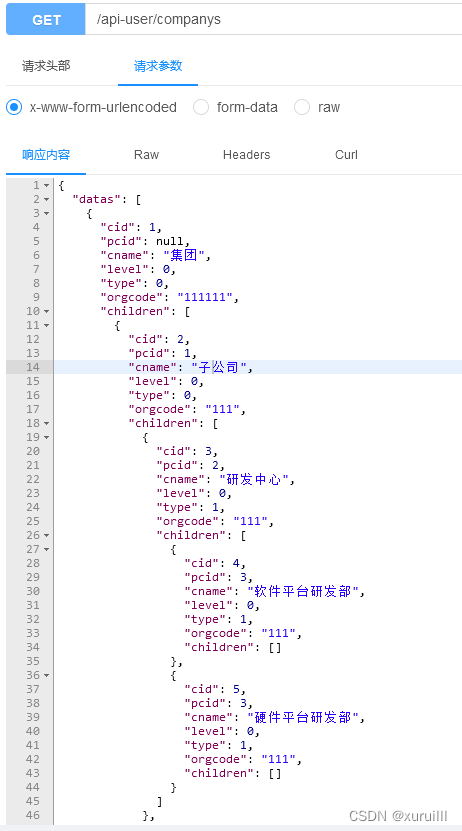最近把用户管理服务切换成PostgreSql数据库,和Mybatis整合时遇到了几个坑,记录一下。
基础设置
application.yml设置,注意schema的设置
spring:
datasource:
platform: postgres
url: jdbc:postgresql://192.188.1.245:5432/uum?currentSchema=uum
schemaName: uum
username: xxxx
password: xxxx
driver-class-name: org.postgresql.Driver
自增字段
关于自增字段,postgresql中没有自增字段,用的是sequence,比如user表中的主键id字段:
create sequence uum.userid_seq start with 1 increment by 1 no minvalue no maxvalue cache 1;
alter sequence uum.userid_seq owner to smartsys;
alter table uum.user alter column id set default nextval('uum.userid_seq');
插入时的sql,id不传入。
<insert id="insertUser" useGeneratedKeys="true" keyProperty="id" keyColumn="id" parameterType="com.sifang.uum.model.Cuser">
insert into cuser(uname, realname, password, phone, email, user_type, deleted, birthday) values(#{uname}, #{realname}, #{password}, #{phone}, #{email}, #{userType}, #{deleted}, #{birthday})
</insert>
service层中获取插入的id:
baseMapper.insertUser(user);
int id= user.getId();
递归获取单位树列表
获取一个单位所有子单位,company表中含有cid和pcid,分别是单位的id和父单位的id,最顶层的单位id为null。想查询出树列表。
class Company是直接根据数据库生成的model,class CompanyVo在Company基础上加了字段
private List<CompanyVo> children;
通过递归调用获取单位的树列表:
public List<CompanyVo> companyTree() {
// 调用mybatisplus的默认函数获取所有单位
List<Company> list = this.list();
// 获取所有最顶层的单位
List<CompanyVo> parentList = getParentList(list);
// 递归调用填充子单位
List<CompanyVo> allList = getChildrenList(list, parentList);
return allList;
}
private List<CompanyVo> getParentList(List<Company> list) {
List<CompanyVo> parentList = new ArrayList<>();
list.forEach(comp ->{
if(comp.getPcid() == null) {
parentList.add(new CompanyVo((comp)));
}
});
return parentList;
}
private List<CompanyVo> getChildrenList(List<Company> list, List<CompanyVo> parentList) {
parentList.forEach(parent -> {
List<CompanyVo> childrenList = new ArrayList<CompanyVo>();
list.forEach(comp -> {
if(parent.getCid() == comp.getPcid()) {
childrenList.add(new CompanyVo(comp));
}
});
parent.setChildren(getChildrenList(list, childrenList));
});
return parentList;
}
Swagger页面测试:

获取一个单位及其子单位下所有用户列表
每个单位通过一个rel_comp_user关系表和用户表做了关联,想获取一个单位及其所有子单位的人员列表。
service层代码
public Page<Cuser> listAllUser(Page<Cuser> page, int cid) {
// 获取编号为cid的单位的所有子单位的列表
List<Integer> allChile = baseMapper.listAllChildComp(cid);
if(allChile.size() > 0) {
String str = "'";
for(int i=0; i<allChile.size(); i++) {
str += allChile.get(i).toString();
if(i != allChile.size() - 1) {
str += ",";
}
}
str += "'";
System.out.println(str);
// 获取所有这些单位的人员列表
return baseMapper.listAllChildUser(page, str);
}
else {
return null;
}
}
Mapper层,不能直接写in语句,需要用where position,把获取的所有单位编号转换成一个字符串传入:
<select id="listAllChildComp" parameterType="java.lang.Integer" resultType="java.lang.Integer">
WITH RECURSIVE T ( cid, pcid ) AS (
SELECT
A.cid,
A.pcid
FROM
company A
WHERE
A.cid = #{cid} UNION ALL
SELECT
b.cid,
b.pcid
FROM
company b,
T
WHERE
b.pcid = T.cid
) SELECT cid FROM T
</select>
<select id="listAllChildUser" resultType="com.sifang.uum.model.Cuser">
select cuser.id id, cuser.uname uname
from cuser
left join rel_comp_user on cuser.id=rel_comp_user.uid
where position(','||rel_comp_user.cid||',' in ','||${childComp}||',')>0
</select>
swagger页面测试:






 本文介绍如何将用户管理服务从MySQL迁移到PostgreSQL,并与MyBatis框架进行整合。文章详细记录了配置过程、自增字段的实现方式、递归获取单位树列表的方法及如何使用递归查询获取单位下的所有用户。
本文介绍如何将用户管理服务从MySQL迁移到PostgreSQL,并与MyBatis框架进行整合。文章详细记录了配置过程、自增字段的实现方式、递归获取单位树列表的方法及如何使用递归查询获取单位下的所有用户。
















 1878
1878

 被折叠的 条评论
为什么被折叠?
被折叠的 条评论
为什么被折叠?








